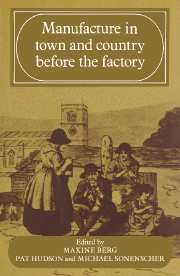Book contents
- Frontmatter
- Contents
- List of illustrations
- Acknowledgements
- 1 Manufacture in town and country before the factory
- 2 Political economy and the principles of manufacture 1700–1800
- PART I THE STRUCTURE OF MANUFACTURE
- PART II ‘WORK’ AND ‘WAGES’
- Appendix 1 Norwich embezzlement convictions in the eighteenth century: problems of evidence
- Appendix 2 Estimates of the size of the supplement to wages available through embezzlement in two eighteenth-century industries
- Appendix 3 Statutes concerned with embezzlement in the putting-out industries, 1500–1800
- Index
1 - Manufacture in town and country before the factory
Published online by Cambridge University Press: 16 October 2009
- Frontmatter
- Contents
- List of illustrations
- Acknowledgements
- 1 Manufacture in town and country before the factory
- 2 Political economy and the principles of manufacture 1700–1800
- PART I THE STRUCTURE OF MANUFACTURE
- PART II ‘WORK’ AND ‘WAGES’
- Appendix 1 Norwich embezzlement convictions in the eighteenth century: problems of evidence
- Appendix 2 Estimates of the size of the supplement to wages available through embezzlement in two eighteenth-century industries
- Appendix 3 Statutes concerned with embezzlement in the putting-out industries, 1500–1800
- Index
Summary
Well before the advent of the factory system, wealth in Europe was visible in the form of an immense accumulation of commodities. Richard Steele's engagingly exotic ‘Fashionable Inventory’, published in The Tatler in 1711, presented a range of items–from a ‘musk coloured velvet mantle lined with squirrel skins’ and a ‘silver cheese toaster’, to ‘seven cakes of superfine Spanish wool, half a dozen of Portugal dishes and a quire of paper from thence’ – whose rich detail testifies to the magnitude and diversity of the world of goods available for opulent consumption in metropolitan society in the age of manufacture. Defoe in 1726 described the immense extent of England's inland trade which ‘extended in every part of the island’. Almost every manufacturing county of England was employed in making the various components of a suit of clothes consisting of a coat of woollen cloth that came from Yorkshire, a waistcoat of cullamancoe from Norwich, breeches of strong drugget from Devizes and Wiltshire, stockings of yarn from Westmorland, a hat of felt from Leicestershire, gloves of leather from Somerset, shoes from Northampton, buttons from Macclesfield or, if metal, from Birmingham, garters from Manchester, and a shirt of handmade linen from Lancashire or Scotland. How was this wide range and quality of goods made? How was the work of those who produced them perceived and lived? What was manufacture without machines? Surprisingly, adequate answers to these questions are likely to be hesitant and tentative.
In many respects, current understanding of manufacture before the advent of factory production is not all that different from the excellent but brief characterisation produced nearly thirty years ago by T. S. Ashton.
- Type
- Chapter
- Information
- Manufacture in Town and Country Before the Factory , pp. 1 - 32Publisher: Cambridge University PressPrint publication year: 1983
- 3
- Cited by



